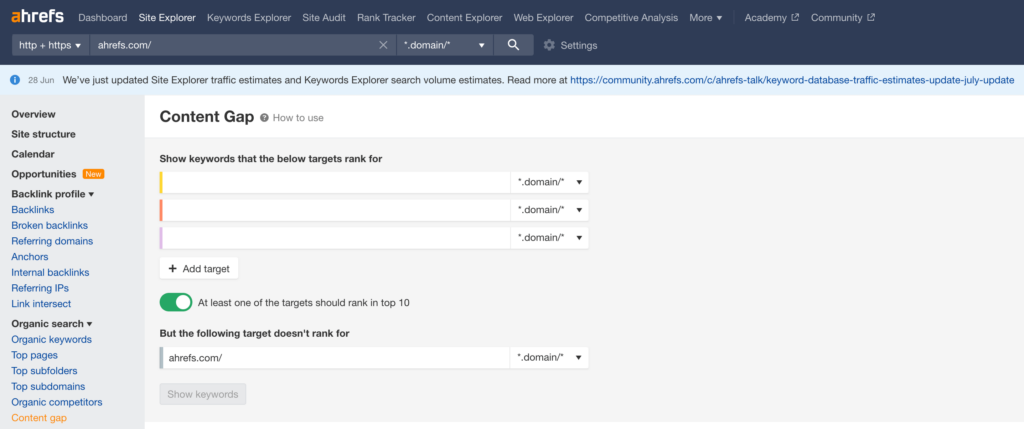
Mastering the art of SEO is akin to owning a powerful key to online success. As companies and content creators compete for visibility and prominence, and in doing so strive to make their mark, a key strategy emerges: understanding and closing content gaps.
Let’s say you’ve carefully crafted your website, provided it with quality content, and done thorough keyword research. However, there is a subtle feeling that something is not right. Perhaps it’s the content gap, which reflects the mismatch between the existing content on your website and the content your audience is looking for, often resulting in missed opportunities in the competitive realm of digital visibility.
Consider a scenario in which your competitors seem to effortlessly secure higher positions on search engine results pages. The mystery lies in their ability to effectively fill gaps in content. They don’t just create content – they develop solutions that match what users are looking for. This strategic prowess puts them ahead of the digital race.
In the SEO maze, content gap analysis becomes a guiding light. It is not just about what is missing, but about content optimization and exploiting the opportunities that lie ahead.
In this article we’ll explore the intricacies of keyword, topic, and media gaps, uncover the undeniable benefits of this practice, and provide you with the content gap analysis tools to help you get started on overcoming your content gap.
What is a Content Gap?
Understanding the concept of content scarcity in SEO is akin to gaining a strategic advantage over your digital competitors. The content gap is the gap that exists between the content you currently offer on your website and the content your target audience is actively searching for. It’s a subtle difference between being discovered by search engine users and simply existing in the vast digital space.
These gaps show up as missed opportunities preventing your website from ranking at the top of search engine results.
Significance of Content Gaps
To understand the importance of content gaps, consider the role of keywords, the cornerstones of online search. When users enter queries into search engines, they use certain keywords to articulate their search intent. A content gap occurs when your site does not have content that is optimized for those keywords. As a result, your website remains invisible to users actively searching for information related to those keywords.
Whitespace in content is not evidence of negligence. Rather, they represent an inherent challenge in the ever-evolving digital realm. As trends change, search queries change, and user preferences change, new content gaps appear. So the art of SEO is not just about content creation, but about constantly identifying and filling those gaps to meet the needs of your audience.
Think of content gaps as uncharted territory on a map of digital relevance. Navigating these territories requires a clear understanding of user intent and a strategic approach to creating content that resonates. It’s not just about creating words on the screen. It’s about providing solutions, ideas, and experiences that users are actively seeking. And our SEO agency is ready to provide you with all kinds of support along the way.
Types of Content Gaps
Content gaps come in many forms, each highlighting a particular aspect of your website’s visibility and relevance in the digital world. Let’s take a look at the three main types of content gaps and understand how they affect your SEO efforts.
1. Keyword Gaps
A keyword gap occurs when your website fails to rank for specific keywords that are relevant to your industry or niche. These keywords might be directly related to your products, services, or the pain points your audience is trying to address. By identifying and addressing keyword gaps, you can ensure that your website is visible to users actively seeking solutions you offer.
For example, you run an online pet supply store, but you’ve inadvertently overlooked keywords like “organic dog treats” or “durable cat toys.” If your competitors are ranking for these keywords and you’re not, you’re missing out on potential customers searching for precisely what you provide. That is why it is very important to do competitor keywords analysis.

2. Topic Gaps
Topics encompass a broader spectrum of content and user interests. A topic gap arises when your competitors cover subjects that you haven’t explored yet. While keywords are specific search queries, topics embody a cluster of related keywords and questions. Addressing topic gaps means delving into areas that resonate with your audience but have remained untapped in your content strategy.
For instance, you’re a fitness enthusiast running a blog. If your competitors are consistently publishing guides on “high-intensity interval training,” and you’re solely focusing on general workout advice, you’re overlooking a valuable topic gap that could attract a dedicated readership.
3. Media Gaps
Content isn’t limited to text, it extends to various media formats, including images, videos, infographics, and interactive tools. A media gap occurs when your competitors are utilizing multimedia content to engage their audience, while your website relies primarily on text-based content. Different users have different preferences when it comes to consuming information. Addressing media gaps involves diversifying your content offerings to cater to various learning styles and preferences.
Let’s say you run a DIY home improvement website, and your competitors are sharing video tutorials on remodeling projects. If you’re not incorporating videos into your content mix, you might be missing out on a visually-oriented audience seeking step-by-step demonstrations.
Understanding these different types of content gaps is the first step in your SEO content gap analysis process.
What are the Benefits of Content Gap Analysis?
In the complex world of SEO, where algorithms evolve and user behavior changes, staying one step ahead is a constant endeavor. This is where content gap analysis becomes a powerful ally, offering many benefits that can transform your digital presence.
- 1. Strategic Insight: Content gap analysis is gaining a profound understanding of your competitors’ strategies. By dissecting their content landscape, you unearth the keywords they’re targeting, the topics they’re dominating, and the mediums they’re leveraging. This strategic insight provides a roadmap for refining your content strategy and outmaneuvering your rivals.
- 2. Enhanced Relevance: Search engines are constantly fine-tuning their algorithms to serve users with the most relevant content. SEO content gap analysis allows you to align your content offerings precisely with user intent. By addressing gaps in keywords and topics, you ensure that your website surfaces for searches that matter, solidifying your relevance in the eyes of both users and search engines.
- 3. Unveiling Untapped Opportunities: Content gaps aren’t just voids, they’re opportunities waiting to be seized. By identifying keywords and topics that your competitors haven’t fully explored, you position yourself as a pioneer in uncharted digital territories. This proactive approach can lead to increased traffic, engagement, and ultimately, conversions.
- 4. Seamless User Journey: A content strategy also includes creating a seamless user experience. By bridging content gaps, you guide users on a consistent path from their initial search queries to finding exactly the solutions they are looking for on your website. This creates a positive impression and encourages repeat visits.
- 5. Amplified Authority: In the eyes of both users and search engines, authority is paramount. Consistently addressing content gaps establishes your website as a go-to resource in your niche. As your content repertoire expands, so does your authority, elevating your chances of ranking higher and commanding user trust.
- 6. Versatile Content Mix: Embracing different content mediums is essential to cater to diverse user preferences. SEO gap analysis often reveals opportunities to diversify your content mix by incorporating videos, infographics, podcasts, and interactive elements. This versatility not only engages a broader audience but also sets you apart as an innovative content creator.
By now, the benefits of competitive content gap analysis should be clear: it’s not merely a process, it’s a strategic investment in your digital success.

How to Do a Content Gap Analysis
Getting started with content gap analysis requires a strategic approach and the right tools at your disposal. Here we describe the steps to conduct a complete content gap analysis that will enable you to refine your SEO strategy and grow your online presence.
1. Map User Journeys
First, put yourself in your users’ shoes. Map out their potential journey from search query to content consumption. This perspective helps you tailor your content to provide a seamless, informative, and engaging experience.
2. Conduct Thorough Market Research
The second step in your SEO gap analysis involves conducting thorough market research. Explore industry forums, social media discussions, and customer feedback to identify gaps that might not be apparent through keyword research alone. Connect with potential clients, current clients, and industry experts either through direct interviews or by sending out surveys for feedback.
Address people at different stages of the buyer’s journey by distributing market research surveys to various segments of your audience. Make your surveys impactful by asking questions like:
- • What are your main goals?
- • What challenges are you trying to overcome?
- • Where do you seek solutions to your problems?
- • Which solutions have you tried and why didn’t they work?
- • What information do you need to reach your goals?
- • What concerns you the most about [topic]?
- • What questions do you have regarding [topic]?
- • Why did you choose [a product/service]?
After receiving feedback, a deeper understanding of how people find your products/services online will emerge. Their reasons for doing so and the nuances of their anxiety will become apparent. This new perspective can be a source of inspiration, helping to formulate new content concepts.
3. Keyword Gap Analysis
Next, you need to identify keywords that your competitors rank for but are missing from your content. Tools like Ahrefs, SEMrush, and Moz can help you identify these keyword gaps. Analyze search volume, keyword difficulty, and relevance to determine which gaps should be addressed first.
4. Content Quality Assessment
Content gap analysis isn’t solely about quantity, it’s about quality too. Assess the depth, accuracy, and relevance of your content and content of your competitors. For Google, the quality of content is an important factor in Google’s ranking system. This insight will help you craft content that not only fills gaps but also surpasses existing offerings.
5. Filling In The Gaps
You are now ready to develop an exceptional content marketing strategy that will take your results to new heights. It’s time to fill the content gaps you’ve identified with new content that’s better than your competitors. Your new content should be detailed, compelling, and helpful.
Creating high-quality content in an already saturated market is challenging, but achievable given the time and resources to put it into practice. By filling in all the gaps you have, you will not only attract more traffic. You will also create a seamless customer journey for everyone who comes to your site.
As you embark on your content gap analysis journey, keep in mind that it’s not just about mimicking competitors – it’s about leveraging their insights to carve a unique path. By addressing gaps strategically, you position your website as a valuable resource that meets users’ needs comprehensively. This, in turn, fosters organic growth, improved search engine rankings, and a loyal audience.
Content Gap Analysis Tips
As you navigate the complex realm of competitive content gap analysis, here are some valuable tips to improve your approach and deliver effective results:
- • Long Tail Keywords Matter: Don’t disregard long tail keywords – those longer, more specific search queries. They often indicate higher user intent and can lead to valuable, niche-specific traffic.
- • Experiment with Formats: Explore different content formats to diversify your offerings. Videos, infographics, podcasts, and interactive tools can cater to various learning styles and user preferences.
- • Leverage Google Search Console: Google Search Console provides insights into the keywords your website is already ranking for. Compare these with your target keywords and competitor rankings to identify additional gaps.
- • Monitor and Iterate: SEO is an ongoing endeavor. Regularly monitor your content gap analysis results and track the impact of your efforts. As trends shift and new gaps emerge, adapt your strategy accordingly to maintain your competitive edge.
- • Seek Professional Expertise: If navigating the intricacies of content gap analysis feels overwhelming, consider seeking professional assistance. We at Mellow Promo offer specialized content gap analysis services to ensure a strategic approach that maximizes results.
With these tips in mind, you’ll be well equipped to strategically fill content gaps and build a solid digital presence. As you apply these ideas and techniques, remember that content gap analysis is an ongoing process. The digital world is evolving, and your content strategy must evolve with it to stay at the forefront of user intent and search engine algorithms.





